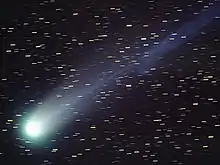| Discovery | |
|---|---|
| Discovered by | William Frederick Denning |
| Discovery date | 4 October 1881 |
| Orbital characteristics | |
| Epoch | 2014-07-02 (JD 2456840.5)[1] |
| Aphelion | 7.884 AU (Q) |
| Perihelion | 0.7842 AU (q) |
| Semi-major axis | 4.334 AU (a) |
| Eccentricity | 0.8191 |
| Orbital period | 9.02 yr |
| Inclination | 9.17° |
| Last perihelion | 2023-Jun-15[1] 2014-Jul-11[1] 2005-Jun-20[1] |
| Next perihelion | 2032-May-14[2][3] |
| Earth MOID | 0.085 AU (12.7 million km)[4] |
| Physical characteristics | |
| Dimensions | 2 ± 1 km (uncertain)[5] |
72P/Denning–Fujikawa is a periodic comet discovered on 4 October 1881 by William Frederick Denning.[6] The comet was not seen at another apparition until recovered by Shigehisa Fujikawa in 1978. From 29 December 1978 until 17 June 2014, the comet was lost. On 17 June 2014 the comet was recovered by Hidetaka Sato at apparent magnitude 16 when it was 50 degrees from the Sun.[7] The comet came to perihelion in June 2023,[1] and will next come to perihelion in May 2032.[2]
There were failures to recover the comet during perihelion even in cases where it is estimated that it should have been around magnitude 8, such as in 1960 and 1969, and it has been suggested since then it is only occasionally active.[5] This has resulted in it being classified as a transitional comet.[5] The comet was seen in 1978 at around magnitude 10. The comet was missed in 1987, 1996, and 2005 as it is now expected that the comet only brightened to about magnitude 13–14 during those passages.[8]
In August 1881 the comet passed 0.116 AU (17.4 million km) from Earth.[3] Between 1855 and 2059 perihelion will gradually be lifted from 0.79 AU to 0.82 AU.
| Date & time of closest approach |
Earth distance (AU) |
Sun distance (AU) |
Velocity wrt Earth (km/s) |
Velocity wrt Sun (km/s) |
Uncertainty region (3-sigma) |
Reference |
|---|---|---|---|---|---|---|
| 2190-Nov-28 19:13 ± 11 hours | 0.126 AU (18.8 million km; 11.7 million mi; 49 LD) | 0.999 AU (149.4 million km; 92.9 million mi; 389 LD) | 18.8 | 39.7 | ± 550 thousand km | Horizons |
Meteor shower
The 1834 trail of comet 72P/Denning–Fujikawa may come close to Earth on 7 January 2024 20:38 UT, but will need to be detected by radio/radar methods as the radiant will be near the Sun and Beta Capricorni.[9] Meteor showers from 72P are more likely to occur in August or December, with December being a daytime event.[5]
References
- 1 2 3 4 5 "72P/Denning-Fujikawa Orbit". Minor Planet Center. Retrieved 2014-06-19.
- 1 2 "Horizons Batch for 72P/Denning-Fujikawa (90000727) on 2032-May-14" (Perihelion occurs when rdot flips from negative to positive). JPL Horizons. Archived from the original on 2023-05-03. Retrieved 2023-07-06. (JPL#K236/6/Soln.date: 2023-Jul-05)
- 1 2 Kinoshita, Kazuo (2014-06-22). "72P/Denning-Fujikawa past, present and future orbital elements". Comet Orbit. Retrieved 2023-08-09.
- 1 2 "JPL Small-Body Database Browser: 72P/Denning-Fujikawa" (last observation: 2023-06-20). Jet Propulsion Laboratory. Retrieved 2023-08-09.
- 1 2 3 4 Beech, Martin (11 November 2001). "Comet 72P/Denning–Fujikawa: down but not necessarily out". Monthly Notices of the Royal Astronomical Society. 327 (4): 1201–1207. Bibcode:2001MNRAS.327.1201B. doi:10.1046/j.1365-8711.2001.04822.x.
- ↑ Kronk, Gary W. "72P/Denning-Fujikawa". Retrieved 2014-06-19. (Cometography Home Page)
- ↑ "MPEC 2014-M11 : COMET 72P/DENNING-FUJIKAWA". IAU Minor Planet Center. 2014-06-18. Retrieved 2014-06-19.
- ↑ Seiichi Yoshida (2023-05-13). "72P/Denning-Fujikawa". Seiichi Yoshida's Comet Catalog. Retrieved 2023-08-09.
- ↑ "2024 Meteor Shower Calendar" (PDF) (Page 3 Section 3). International Meteor Organization (IMO). Retrieved 2023-08-06.
External links
- Orbital simulation from JPL (Java) / Horizons Ephemeris
- 72P at Kazuo Kinoshita's Comets (1855–2105)
- Mikhail Maslov

.png.webp)